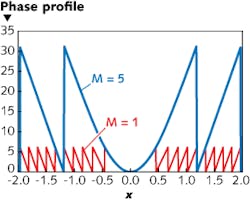Researchers at the University of Eastern Finland (Joensuu, Finland) have broadly theoretically examined the use of different optical elements used for spatially shaping spatially coherent but broadband light beams, either continuous-wave (CW) or pulsed; such light sources include, for example, superluminescent LEDs (SLEDs). The researchers considered diffractive optics of different forms including standard first-order diffractive elements and harmonic diffractive optical elements (which have a phase change of M2π between diffractive zones where M is greater than 1). In particular, they examined the use of such optics for the very important case where a Gaussian beam is transformed into some other shape (for example, flat-top) that is more desirable for the task at hand. They examined broadband spectral rages from relatively small (tens of nanometers) to large (the entire visible spectrum). Their examination included Fourier- and Fresnel-domain beam planes.
Based on beam-propagation equations, they came up with a number of practical conclusions. First, if the spectrum is reasonably narrow (no more than tens of nanometers) and symmetric about its central frequency, then standard diffractive beam shaping elements work well. Examples covered by this case include beams produced by many pulsed femtosecond lasers, as well as by SLEDs. When examining very broadband light (for example, that produced by supercontinuum sources), the researchers determined that the use of low-harmonic diffractive elements with M greater than 4 were preferable, for one because they did not interfere much with the color distribution (behaving similarly to refractive optical elements). In contrast, when shaping a very broadband beam into a flat-top shape, standard diffractive beam shaping elements (M=1) produced widely varying colors across the flat-top. Contact Manisha Singh at [email protected].
